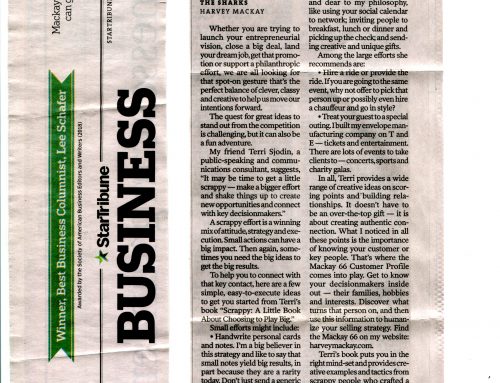Big news! Terri was featured on the cover of the November issue of Sales & Service Excellence Magazine. She also contributed an article, which you can read here:
Persuasion: It’s More than Information
In today’s competitive marketplace, a sales professional’s success often depends upon his or her ability to deliver a polished and persuasive presentation. Although salespeople spend 80 percent of their time verbally communicating, many suffer from common shortcomings in their sales presentations that adversely affect their results. One of the most common mistakes is delivering overly informative presentations. Of course, every solid presentation requires a certain amount of “data,” but many professionals spend too much time informing rather than persuading.
It’s easy to deliver an informative rather than persuasive presentation. The reason? A prospect typically won’t say “no” when you’re only disseminating information. The problem is they don’t say “yes” either!
One woman reluctantly confessed that she suffered from the data-dump syndrome. She was afraid of being perceived as “hard sell,” and didn’t know how to pull out the best selling points. Like many of us, she felt more comfortable in the information zone. She realized she had spent too much time sharing and consulting with her sales prospects without completing any transactions. Bummer! Her strategy was to provide more information than her competitor did. She hoped that her prospect would like her more or at least feel obligated to buy from her because she had been so thorough.
After reevaluating her presentations, she realized she needed to move beyond merely relaying information; she needed to build her case. By focusing more on brevity and tailoring her strongest points to her prospects’ needs, this young professional eventually became a consistent producer in her organization.
What makes a persuasive case?
 Prepare like a debater or an attorney. Debaters and attorneys win cases based on persuasive arguments and supporting evidence. Focus on your most compelling arguments with each client or prospect.
Prepare like a debater or an attorney. Debaters and attorneys win cases based on persuasive arguments and supporting evidence. Focus on your most compelling arguments with each client or prospect.
Do you deliver a presentation that creates a true need for your product or service that your prospect may not even be aware of? (Ask yourself why you, why your company, why now?) Don’t just deliver a standard list of features and benefits. (A feature is what something is. A benefit is what something does.)
Your goal is to be both informative and persuasive, pairing rock-solid information with compelling arguments. I have seen it play out time and again. If you are too informative, nothing happens. If you are too aggressive, nothing happens. Find a balance, and you’ll see results.




Leave A Comment